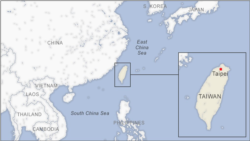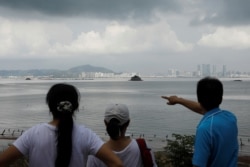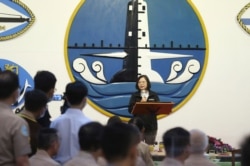Chinese civil aviation authorities are working on a new civilian airport on Dadeng Island, less than 10 kilometers from the Taiwanese-held island of Kinmen, and Chinese ships can be spotted in sea tracts uncomfortably close to Taiwan’s turf, dredging for gravel.
That’s what Shih Chao-min, chairman of Kinmen county’s ruling Nationalist Party, has observed for the past few years.
Taiwan’s central government has noticed too. It says the Chinese ships are illegally looking for gravel in waters close to Taiwanese land. A lot turn up near Kinmen and Matsu, another outlying archipelago, because of their proximity to China.
“Due to the needs of their project, they often go and extract gravel from the sea, but there’s quite an impact on us,” Shih said. “We’re paying careful attention to this matter. There should be a channel the two sides can use to communicate.”
Careful attention matters because China has been pressuring it in other ways off and on for decades. China believes Taiwan belongs under its flag, but Taiwan rejects that idea. Taiwan been self-ruled since the Chinese civil war of the 1940s, when Chiang Kai-shek’s Nationalists lost and re-established themselves in Taipei.
Every day Chinese military planes enter Taiwan’s air defense identification zone and aircraft carriers periodically pass nearby. China has not renounced the threat of force, if needed, to unify with Taiwan.
Chinese dredging has taken place in Taiwanese waters for about a decade, and it damages the marine ecology, said Chen Yi-fan, assistant diplomacy and international relations professor at Tamkang University in Taiwan.
Taiwanese coast guard vessels were sent to disperse about 4,000 Chinese dredgers in Taiwanese waters in the first 10 months of 2020, the government-run Central News Agency reported. That number has increased over the past few years as illegal dredging intensifies, the Taiwan government’s Mainland Affairs Council told VOA Monday.
The coast guard can’t deter as many ships as China allows to dredge, Chen said.
Dredging persists partly because the Chinese ships at least start off on the high seas, Shih believes. Sometimes they plumb for gravel in tracts that overlap the claims of China and Taiwan, which extend six kilometers offshore from Kinmen and Matsu rather than the usual 12 nautical miles (22.2 kilometers), Chen said.
“These grey zone operations may go on just like the PLA Air Force breaking into Taiwan’s ADIZ on a regular basis,” Chen said. China does not recognize the Taiwanese ADIZ, or air defense identification zone.
The search for offshore gravel in waters claimed by Taiwan has “very strong political context,” he added.
China might steer its dredging ships away from Taiwanese land if political ties were better, said Yun Sun, East Asia Program senior associate at the Stimson Center.
Relations have slumped since 2016, when Beijing called off formal talks after Taiwan President Tsai Ing-wen declined a dialogue precondition that Taiwan belongs to China.
Now China is “more inclined to take a hardline position rather than a more nuanced position,” Sun said.
“At least we can see very clearly that the mainland Chinese authority didn’t even try to stop it or did not try to put a cap on it, so by itself I think that is a political messaging,” she said.
In December, Taiwan’s parliament approved laws that increase the penalties for illegal sand dredging in coastal waters to one to seven years in prison and fines up to $3.5 million.
Previous penalties stopped at $1.8 million and five years in jail.
“We hope that the government can show its law enforcement resolve by making the penalties heavier,” the Mainland Affairs Council said in an e-mail.
China passed a law January 22 that expressly allows its coast guard to fire on foreign vessels, a move that scholars say gives Beijing more power over five governments that contest its claims to the 3.5 million-square-kilometer South China Sea southwest of Taiwan. The law means Chinese coast guard vessels might accompany dredgers to ward off any threats, Chen said.
Construction on part of the Xiamen Xiangan Airport just off Kinmen is set to end by 2024. The airport is being designed to handle 45 million passengers by 2025.











